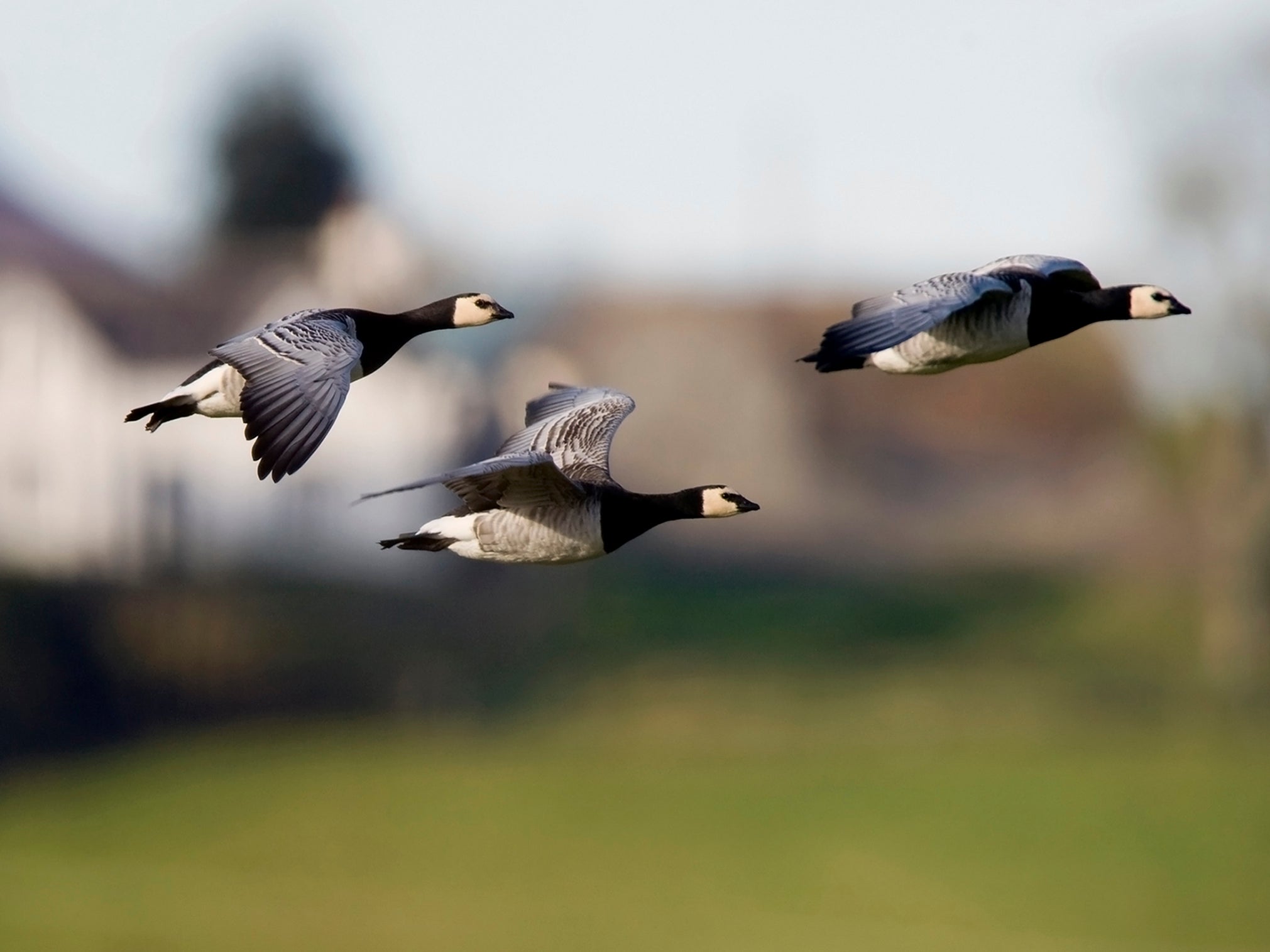Science in brief: From climate change speeding up bird migration to the benefit of sending thank you notes
And a roundup of other stories from around the world

These birds are racing to their mating grounds. It’s exhausting
Shifting environmental signals caused by global warming are making barnacle geese race northward on their spring migration, flying faster and skipping the stops they normally use to rest and refuel, according to a study published recently in the journal Current Biology.
“This is the first one I know of where a long distance migrant is increasing its travel speed,” says Matthew P Ayres, a professor of biology at Dartmouth College.
The geese spend their summers in the Arctic, where warmer temperatures transform the snowy landscape into an all-you-can-eat buffet of grasses, roots and mosses.
Their migration is triggered by changes in daylight. As days grow longer in spring, the geese take sunlight as a cue to head north. The goal is to arrive early enough in the spring to take advantage of the tender spring greens that are especially beneficial for chicks.
Once the birds are en route, environmental cues like lots of greenery make them realise that spring has arrived early in the north. The geese take the time to rebuild their strength when they arrive, but that means nesting is delayed.
As a result, their chicks are born when the food supply is past its prime. They “hatch while the vegetation is already not optimal, and they grow less and they survive less”, says Bart Nolet, a professor at the Netherlands Institute of Ecology and an author of the study.
Babies’ cries may foretell their adult voices

Research has already shown that the pitch of a person’s voice stays basically the same during adulthood and that how we sound as adults may be determined before puberty. A recent study indicates that the pitch of a boy’s voice at age seven can mostly predict what he will sound like as an adult.
So when do our voices start emerging? One group of researchers hypothesise that differences in pitch would emerge very early – even in babies who have not yet learned how to speak.
Now, their new research – published recently in the journal Biology Letters – indicates that the pitch of babies’ cries at four-months-old may predict the pitch of their speech at age five. In fact, the researchers say, the differences identifiable in babies’ whines can explain 41 per cent of the differences in voice pitch that appear by age five.
Taken together with previous studies, they say, this suggests a discovery that may be surprising: that “a substantial proportion” of the difference between how we sound in adulthood may be traceable back to the time we spend in utero. Indeed, they say, that would explain why there are differences in baby screams so soon after birth.
“In utero, you have a lot of different things that can alter and impact your life – not only as a baby, but also at an adult stage,” says Nicolas Mathevon, a professor who studies animal behaviour at the University of Lyon in France and was one of the authors of the study.
Carolyn Hodges, an assistant professor of anthropology at Boston University who was not involved in the study, says research had shown that voice pitch affects our impressions of a person’s physical and social dominance, attractiveness and trust, which can have real-world consequences.
“There aren’t many studies that address these questions, so that makes this research especially intriguing,” she says.
Still, the researchers caution that their sample size was small and noted that “further investigations involving a larger sample” were needed to confirm the correlations they found.
Fossils trapped in amber offer clues to the origins of snakes
In 2016, Lida Xing was combing the amber markets of Myanmar when a merchant enticed him over to his booth with what he said was the skin of a crocodile trapped in amber. When Xing inspected the specimen and noticed the diamond-shaped pattern of its scales, he realised what he was holding was actually a 99-million-year-old snakeskin.
Xing, who is a palaeontologist from the China University of Geosciences in Beijing, said that of the hundreds of thousands of amber pieces discovered in the area, no one had ever before found a snake.
He purchased the snakeskin and set up a meeting with Michael Caldwell, a snake palaeontologist at the University of Alberta.
A few minutes before Xing boarded his flight to Canada, a different colleague alerted him to another recently discovered snake specimen that was more amazing than the first: entombed in a silver-dollar-size chunk of amber was a baby snake.
“The fossil is the first baby snake and the oldest baby snake to yet be found,” said Xing. Before this finding, palaeontologists had not uncovered a fossilised baby snake even in the rock fossil record, says Caldwell.
Only the bottom half of the baby snake’s sinuous body was preserved in the amber, which is fossilised tree resin. Because the skull was missing, the people who found the fossil thought the tiny creature inside was either a centipede or millipede.
Through the use of a micro-CT scanner and a synchrotron, scientists confirmed that the specimen was a baby snake, a new species they named Xiaophis myanmarensis. It resembles existing species of pipe and grass snakes.
You should actually send that thank you note you’ve been meaning to write
Dear reader,
We are grateful that you are taking the time to read this article. Because without you reading the story, what’s the point?
We are now going to use your precious time to share a surprising new finding: people like getting thank you notes.
OK, it’s not that surprising. But what did surprise two psychologists as they attempted to get to bottom of why so few people actually send thank yous is that many people totally “miscalibrate” the effect of an appreciative email. They underestimate the positive feelings it will bring.
“They think it’s not going to be that big a deal,” says Amit Kumar, a professor at the University of Texas at Austin who studies wellbeing.
But after receiving thank you notes and filling out questionnaires about how it felt to get them, many said they were “ecstatic”, scoring the happiness rating at 4 of 5. The senders typically guessed they’d evoke a 3.
Sample letters included missives of appreciation to fellow students and friends who offered guidance through the college admissions process, job searches and tough times. In lab experiments, Kumar observed that it took most subjects less than five minutes to write the letters.
The study, published in June in the journal Psychological Science, is an effort to fill a hole in gratitude research.
Don’t squish the jellyfish. Catch it with a robotic claw

The ocean is filled with jellyfish. They form critical links in the marine food chain, some are immortal and others remain floating enigmas. Some scientists consider them and other squishy creatures similar to living works of art, and they do not want to kill or injure these masterpieces they are trying to understand.
“It’s almost akin to how a scientist would study a painting in the Louvre,” says David Gruber, a marine biologist at the City University of New York’s Baruch College. “Someone studying the Mona Lisa wouldn’t just cut a piece off and do some analysis on it. We want to get as much information as we can without harming the painting.”
That is why Gruber and a team of engineers and marine scientists are announcing a new invention for studying soft sea creatures like jellyfish or squid in their natural habitat.
The RAD sampler (short for rotary actuated dodecahedron), is essentially a 3D printed, origami catcher’s mitt. It uses a single motor to fold itself from a 20 inch flat star into a 12-sided encasement, 8 inches wide. With it, researchers can gently hold squishy sea animals temporarily for observation without harming, killing or having to bring them to the surface. This sampler, which was detailed recently in a paper in Science Robotics, is part of a larger effort to design robots that aid in the study of our planet’s most mysterious habitat.
“You get used to the fact that there are these animals that won’t get described, or won’t get described by you,” Brennan Phillips, an ocean engineer and remote operated vehicle pilot at the University of Rhode Island and co-author on the study, says.
One day when Phillips was studying at a microengineering lab at Harvard, a graduate student named Zhi Teoh presented a tiny paper model of a polyhedron he had hand-folded, like origami, from a single panel with tweezers under a microscope. After the meeting, Phillips asked if Teoh could make it bigger – to capture sea creatures.
Teoh overcame many challenges, including making it easy to repair, not reliant on too many motors, able to withstand the deep ocean’s pressures and gentle on the animals when it closed.
© New York Times
Join our commenting forum
Join thought-provoking conversations, follow other Independent readers and see their replies
Comments
Bookmark popover
Removed from bookmarks